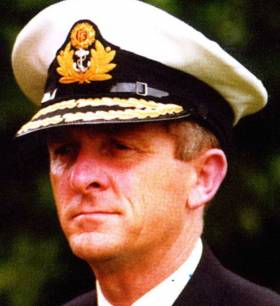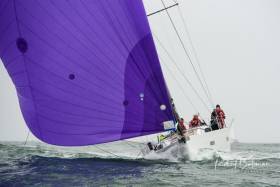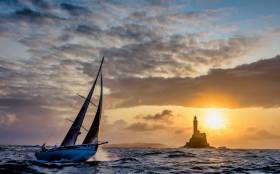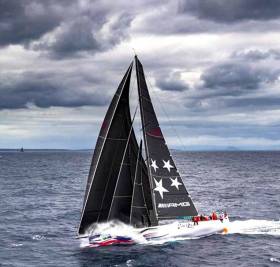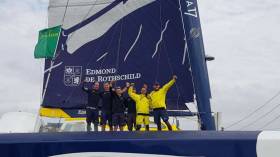Displaying items by tag: Fastnet Race
Naval Services' Role in Fastnet Rescues of 1979 Recalled at Final 2019 Commemoration Service on Cape Clear
The significant role played by the Irish Naval Service in the 1979 Fastnet Race Disaster has sometimes been overlooked in the dramatic images of helicopters and lifeboats in direct action writes W Nixon. But in fact the LE Deirdre under Captain John Kavanagh was on station and directing operations in the western section of the worst affected area for longer than any other vessel, and her reliable services were recalled at a ceremony yesterday on Cape Clear Island which brought to a conclusion the 16-day sequence of 40th Anniversary commemorations, a sequence which began with a Memorial Service in Holy Trinity Church in Cowes on Friday, August 2nd, the eve of the start of the 2019 Fastnet Race.
The Examiner today has the story here
The LE Deirdre’s story was also reported in more detail in The Irish Times at the 20th Anniversary in 1999 here
Fastnet Storm 1979: Today is the Most Poignant in Remembering the Sequence of the Tragedy
It was the 15th August 1979 by the time the full horror of the effects of the Fastnet Race storm had become apparent writes W M Nixon, and today is the most quietly poignant in 2019’s sequence of recollection and commemoration. It is a sequence which began with the Memorial Service in Holy Trinity Church in Cowes on the evening of Friday 2nd August before the 2019 Fastnet Race got under way at noon next day, and it will conclude with a Service of Commemoration on Cape Clear this coming Sunday, with the restored Baltimore RNLI Lifeboat of 1979’s heroic rescues, the Watson 47 The Robert which has been restored by Jeff Houlgrave, the most honoured craft among those visiting the island.
At Afloat.ie in recent weeks, we have covered the Fastnet events of forty years ago in considerable and developing detail. But today is one for quiet contemplation. We salute long-serving Cox’n Kieran Cotter and his crew of Baltimore lifeboat who put in the longest service of any of the rescue organisations, we salute all others involved in the large and complex international rescue operation, and we remember the 19 who were lost their lives, and their families and friends and shipmates.
Most poignant of all is that four of those who died were only accompanying the Fastnet Race. Such was the special nature of the race that some sailing enthusiasts felt sufficiently rewarded by simply sailing in the vicinity of the fleet, and they were to pay with their lives for their their fascination with this extraordinary event. All 19 names are commemorated in a plaque in Holy Trinity Church in Cowes, and a Memorial Stone on Cape Clear. They are remembered today, and they will be remembered again on Cape Clear with a special height of emotion within sight of the Fastnet Rock on Sunday.
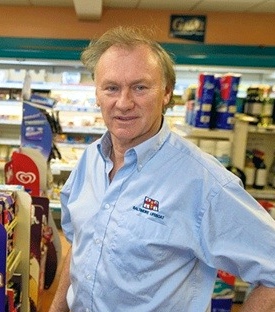 Kieran Cotter, longtime Cox’n of the Baltimore Lifeboat
Kieran Cotter, longtime Cox’n of the Baltimore Lifeboat
RTE's 'Back To The Rock' Adventure Story of Fastnet '79 Disaster
Last weekend's popular documentary series on RTE Radio One dealt with the 1979 Fastnet Yacht Race disaster. 21 people died, many boats were dismasted, abandoned or sunk as the race became a fight to stay alive.
RTE's Back To The Rock is a gripping and evocative adventure story, told from a unique perspective. A story of hurricane winds and waves the size of houses, it is also a story of fear and courage, survival and disaster, and the power and allure of the sea.
The docu interviews many from Irish sailing who sailed in the race that fateful year and who are still very much involved in the scene today such as Cork Harbour's Donal McClement, Sally O'Leary and Neil Kenefick.
The podcast is available here.
Conor Doyle’s Xp 50 Freya from Kinsale – which placed tenth in Class IRC 1A - looks to be the 2019 winner of the Gull Salver for the best-placed Irish boat on corrected time overall in the current Rolex Fastnet Race as the hectic prize-giving swings into action in Plymouth this evening, with the hyper-busy RORC staff working against the clock to ensure that “only about forty cups and trophies” go to the right recipients writes W M Nixon
As it happens, Freya’s skipper will take possession of the Salver in the less frenetic atmosphere of the Irish Cruising Club AGM in the New Year. The Gull Salver is named in honour of Corkman Harry Donegan and his 17-ton cutter Gull. They took part in the first Fastnet race in 1925, placing third, and were also present at the founding of the ICC in Glengarriff in 1929.
Thus the Gull Salver is in the custody of the ICC, although it originated in a 1972 gathering of all Ireland’s Fastnet competitors, including Captain Jim Kelly who as a young man had been on Gull’s 1925 crew. Forty-three years later, this hugely convivial “Fastneteers Dinner” generated a surplus which was then very properly used to fund the Gull Salver, and the ICC has looked after it ever since.
For the past two Fastnet Races, Ireland has provided the winner of the Roger Justice Trophy for the top-placed sailing school boat, with Irish National Sailing School’s J/109 Jedi, skippered by Kenneth Rumball, winning in 2017, while Irish Offshore Sailing’s Sun Fast 37 Desert Star with Ronan O Siochru in charge won in 2015.
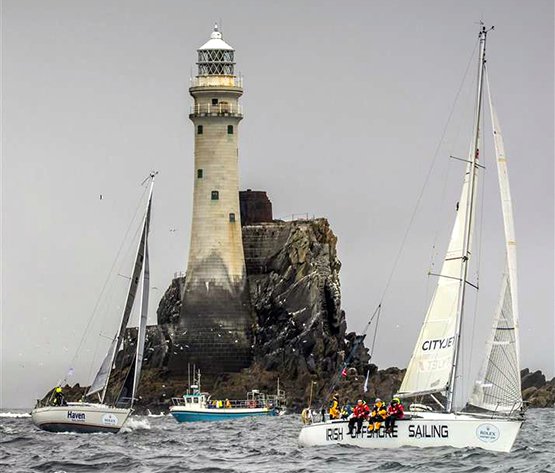 Irish Offshore Sailing’s Desert Star at The Rock in the 2015 Fastnet Race, when she won the Roger Justice Trophy for best Sailing School boat. This year she was in contention again, but had to be content with a podium place narrowly ahead of sister-ship Sherkin Two
Irish Offshore Sailing’s Desert Star at The Rock in the 2015 Fastnet Race, when she won the Roger Justice Trophy for best Sailing School boat. This year she was in contention again, but had to be content with a podium place narrowly ahead of sister-ship Sherkin Two
This year Irish Offshore Sailing had two boats in the race – a remarkable logistics effort for an organisation based in Dun Laoghaire. In addition to Desert Star skippered again by school principal Ronan O Siochru, sister-ship Sherkin Two skippered by Daniel Smith also took part. And however much they tried to avoid it, they ended up having a boat-for-boat duel, with Sherkin Two finishing last night just one minute ahead of Desert Star.
Yet as Desert Star has a slightly lower rating, in the overall rankings she finished ahead of Sherkin Two by two places. And though they were well down the fleet generally, in sailing school terms they were well placed. There was even a slight chance that Desert Star might win the Roger Justice Trophy again.
However, it was not to be, though everything points to them getting a podium place as third in the Sailing Shools division. But with the impending bad weather, they’d to leave before the awards ceremony in order to log some miles back towards Ireland before seeking storm shelter in Newlyn.
Meanwhile, although most of the cups and trophies were going to French boats, there were special cheers for two American boats which had found their journey well worthwhile – the former Volvo 70 Wizard (Peter & Dave Askew) which was lauded as overall winner to add the Fastnet trophies to her already remarkable 2019 record of winning the Transatlantic and the RORC Caribbean races in July and February respectively. And the 50-year old 48ft McCurdy Rhodes design Carina (Rives Potts), a veteran of the 1969 race and also the storm-struck 1979 race, which took the Dorade Trophy for top-placed Classic Yacht.
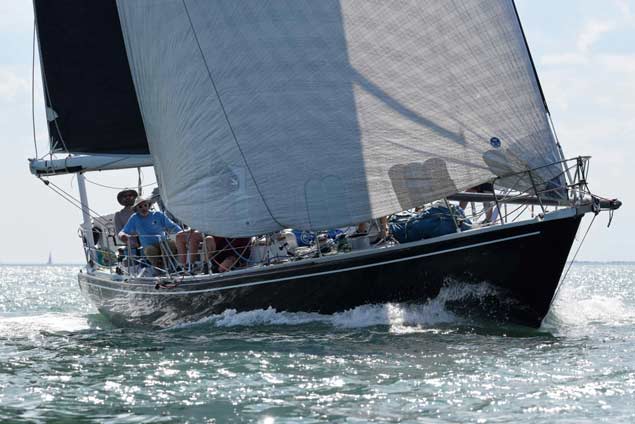 The most golden oldie….Rives Potts’ 48ft Carina has won the Dorade Trophy in her Golden Jubilee year. Photo: Rick Tomlinson/Rolex
The most golden oldie….Rives Potts’ 48ft Carina has won the Dorade Trophy in her Golden Jubilee year. Photo: Rick Tomlinson/Rolex
Fastnet Race 2019 Has Seen The “Wimbledon Effect” Rampant
The “Wimbledon Effect” is pretty well complete with the Rolex Fastnet Race generally, and with the 2019 event, in particular, writes W M Nixon. As with Wimbledon tennis itself, the English organize a jolly good event with this classic offshore challenge, though in the case of the Fastnet Race it’s with a little help from the Irish and our very useful rock, not to mention our weather - and welcome to it.
But in the end, all the main prizes have gone abroad, in the Fastnet Race’s case either across the Channel or across the Atlantic. They certainly haven’t come to Ireland. And yet it’s only a dozen years since Ger O’Rourke of Kilrush was totally triumphant every which way in winning overall with his Cookson 50 Chieftain.
"All the main prizes have gone abroad, in the Fastnet Race’s case either across the Channel or across the Atlantic"
Our only last hope is with the Roger Justice Trophy for the best sailing school boat, and our two contenders in this – both from Irish Offshore Sailing in Dun Laoghaire - are at the time of writing still racing, with the Sun Fast 37 Sherkin 2, skippered by Daniel Smith, slightly ahead of his boss Ronan O Siochru sailing sister-ship Desert Star, both with around 37 miles to go to the finish at Plymouth, and both sailing at 6.3 knots.
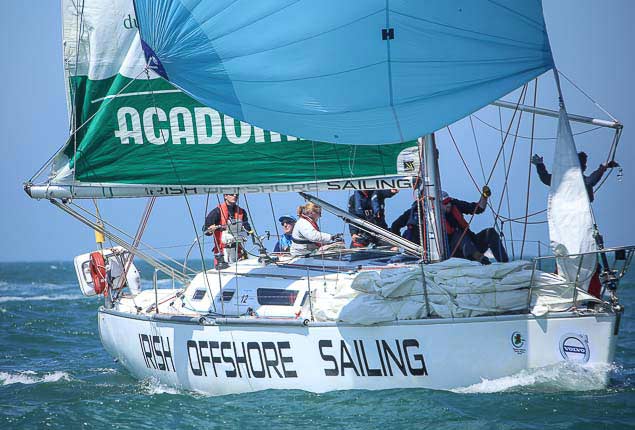 Irish offshore sailing’s Sherkin 2, skippered by Daniel Smith, is currently narrowly ahead of sister-ship Desert Star, skippered by Ronan O Siochru. Photo: Afloat.ie/David O’Brien
Irish offshore sailing’s Sherkin 2, skippered by Daniel Smith, is currently narrowly ahead of sister-ship Desert Star, skippered by Ronan O Siochru. Photo: Afloat.ie/David O’Brien
Meanwhile, the rest of the results are more than clearcut in their message for Irish and UK sailors:
American boat first to finish? Check. It’s George David’s Rambler88.
American boat first overall on IRC? Check. It’s Peter and Dave Askew’s former Volvo 70 Wizard, skippered by Charlie Enright.
French boats dominating most of the other classes? Check. Here’s the Roll of Honour of French boats in the top three in all classes:
Class 0: 2nd Bretagne Telecom (French-designed and built Mach 45)
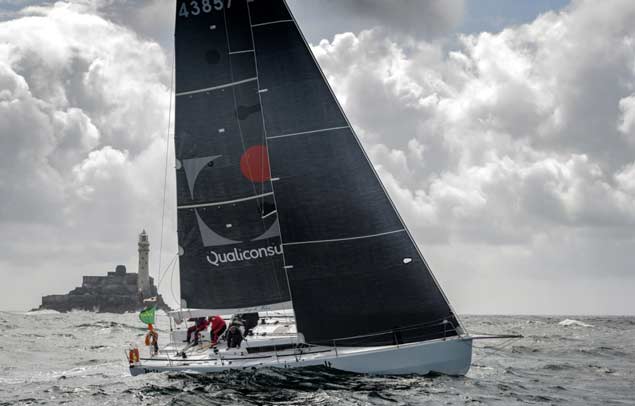 Jacques Pelletier’s Milon 41 L’Ange de Milon is winner of Class 1. Photo: Rolex
Jacques Pelletier’s Milon 41 L’Ange de Milon is winner of Class 1. Photo: Rolex
Class 1: 1st L’Ange de Milon (Milon 41), 2nd Lann Ael (Jnd39, overall winner in 2017, 3rd Tonnere de Glen
Class 2: lst Courrier Recommende (JPK 11.80), 2nd Nutmeg Solidaire En Peleton (MC34)
Class 3: 1st Leon (JPK 10.30), 3rd Dream Pearls (JPK 10.80)
Class 4: 1st Foggy Dew (JPK 10.10), 2nd Gioia (JPK 10.10), 3rd Sun Hill 3.
IRC Two-handed: 1st Leon (JPK 10.30), 3rd Raging-bee (JPK 10.80).
MOCRA: 1st Guyader Gastronomie
Open Multihull: 1st Maxi Edmond de Rothschild (Gitana XVII), 2nd Macif, 3rd Sodebo Ultim
IMOCA 60: 1st Charal, 2nd Prb, 3rd Banque Populaire
Class40: 1st Lamotte-Module Creation, 2nd Beijaflore, 3rd Earendi.
We can draw all sorts of conclusions from this, but if you think it must be something to do with a rigidly-controlled society, perish the thought. On the contrary, it seems to be the result of a society of hugely individualistic people who - in the case of sailing and particularly offshore racing – share a desire to create innovative boats and race them in the most skilled possible way.
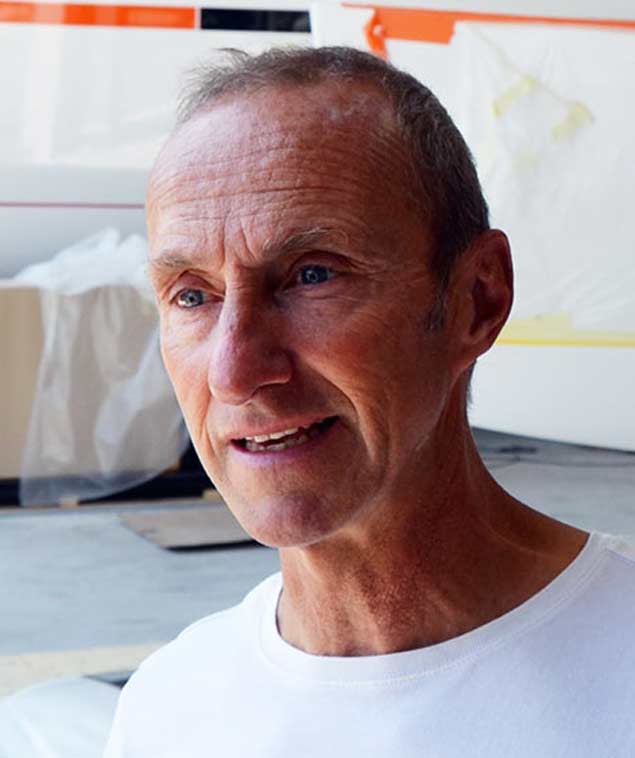 The essence of French enthusiasm – Jean-Pierre Kelbert in his boat-building workshop in Lorient.
The essence of French enthusiasm – Jean-Pierre Kelbert in his boat-building workshop in Lorient.
The classic case in point is Jean-Pierre Kelbert, creator of the JPK range of successful offshore racers which really do perform as good and comfortable cruisers as well. In industry terms, his company is small. But with the Rolex Fastnet Race, JPK Yachts is global in its impact, and we can only hope some venture company doesn’t somehow get its mitts into it and spoil the magic with excessive expansion.
As it happens, the company’s successful boats are the saving of it. If you have a JPK yacht, you have absolutely no excuse for not winning. By buying one, you’re either going to race determinedly, or cruise far and wide with style. There’s no place for limp performance with a JPK. There’s no point in everyone trying to have a JPK.
 Enthusiasm afloat – Alexis Loison (left) and owner-skipper-builder Jean Pierre Kelbert after the JPK 10.30 Leon had crossed the finish line yesterday at Plymouth to achieve multiple wins. Photo: Rolex
Enthusiasm afloat – Alexis Loison (left) and owner-skipper-builder Jean Pierre Kelbert after the JPK 10.30 Leon had crossed the finish line yesterday at Plymouth to achieve multiple wins. Photo: Rolex
The man himself seems to be super-human in his energy and enthusiasm, yet modest with it. He came to sailing through wind-surfing in which he was European champion in 1988 and 1999. But by the turn of the millennium, he was thinking about proper boats and found a kindred soul in designer Jacques Valeur, who designed the first JPK boat when the firm started in 2002, and continues to design a balanced range of performance boats in which the JPK 10.30 – introduced in April this year – is at one end and the JPK 45 – a lift-keel fast cruiser – is at the other.
Even today, Jean-Pierre Kelbert seems to be very personally involved in a direct hands-on way with every boat which his small but select workforce creates. But his enthusiasm doesn’t stop there, for he still relishes sailing.
Thus we watched with interest as the new JPK 10.30 Leon started in the Rolex Fastnet Race 2019 racing in both the Two-Handed Division and Class 3. And as she appeared with more regularity at the front of both fleets, we wondered who might be sailing her. It was the man himself, no less, sailing with Alexis Loison.
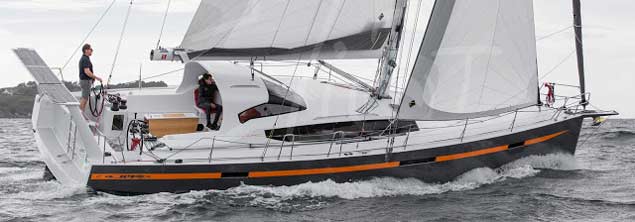 Another aspect of a remarkable product line – the JPK 45 fast cruiser has a lifting keel.
Another aspect of a remarkable product line – the JPK 45 fast cruiser has a lifting keel.
They just went better and better, putting in a stellar performance on the fast leg from the Fastnet to the Bishop, and at the finish not only had they stayed in front to win the Two-Handed Division and Class 3, but they shot up to sixth overall just behind Gery Trentesaux in the JPK 11.80 Courrier Recommande, and otherwise surrounded by much bigger boats.
Monsieur Jean-Pierre Kelbert, we salute you. Meanwhile, here’s a vid of George David’s Rambler 88 doing great things at the other end of the size scale:
When veteran French skipper Gery Trentesaux’s JPK 11.80 Courrier Recommande crossed the Rolex Fastnet Race finish line in Plymouth at 11.22 BST this morning and corrected into fifth place overall a clear 2 hours and 16 minutes behind Peter & Dave Askew’s all-conquering Volvo 70 Wizard, it was put beyond all doubt that the Charlie Enwright-skippered former Volvo round the world racer was unbeatable on the day as she added the Fastnet trophies to her victory in July on the Transatlantic Race writes W M Nixon.
Courrier Recommande had been in with a chance. And she did manage to sail an impressive 257 miles in the final 24 hours of her race. But the steam was going out of the southwest wind as the morning drew on, and the chance – always a fairly remote one - slipped inexorably away. So the race was Wizard’s for the taking, and the Askew/Enright crew thoroughly deserve their success.
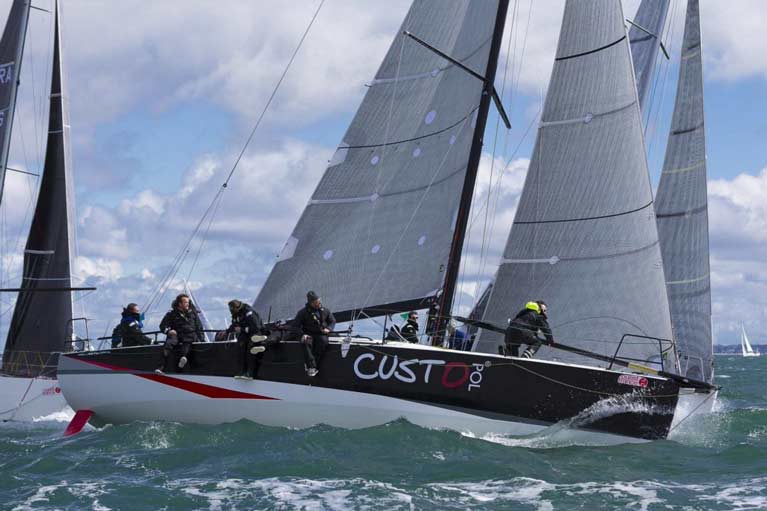 Former overall winner Gery Trentesaux’s JPK 1180 Courrier Recommande was in with a chance of another overall victory
Former overall winner Gery Trentesaux’s JPK 1180 Courrier Recommande was in with a chance of another overall victory
On the outward leg getting through the very sticky patch between Start Point and the Lizard, Wizard was so tactically brilliant in calling her shots that we assumed Ian Moore must be on board. Not so. In fact, the great navigator/tactician sat out this particularly intriguing Fastnet Race, which is everyone’s loss as his insights from direct experience would have added greatly to our understanding of its complexities.
These continue for many boats at sea as they sail through improving conditions while knowing that by this weekend, seriously bad weather may well be sprung upon us all. By that time everyone will be long finished even though it will be of concern to anyone bringing a boat home to Ireland. But for now we see the final acts of the big race being played out knowing that the core of the drama has been resolved.
Or has it? Not at every level, it hasn’t. That’s the attraction of races like the Fastnet and the Round Ireland. The bigger the fleet, the more likely you are to find private duels developing which continue to the finish line regardless of where the duellers may be in the overall placings.
Thus this morning at around 0720, two well-used Jeanneau Sun Fast 37s came past The Rock with Sherkin 2 leading Desert Star by upwards of a couple of miles. Both these boats are with Irish Offshore Sailing of Dun Laoghaire which is in the forefront of introducing Irish people – and people from elsewhere too – to the world of proper sea sailing.
It was quite something that Sherkin 2 was leading Desert Star, as Sherkin is skippered by Daniel Smith, while Desert Star is under the command of school principal Ron O Siochru. On the long reach down to the Isles of Scilly, they’ve taken slightly different lines, but Sherkin 2 is still shown as ahead. And it may well matter a lot when they get to Plymouth tomorrow, as both are in contention for the Roger Justice Trophy for the best-placed sailing school vessel.
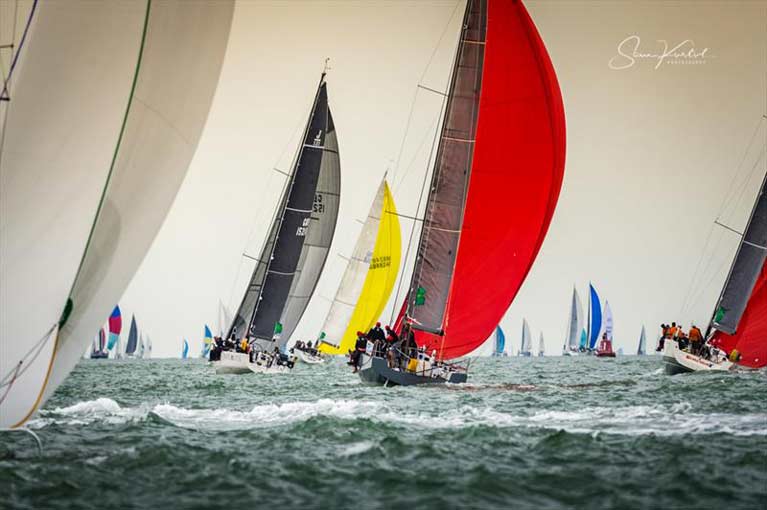 In the huge Fastnet fleet, private inter-boat races can maintain the interest to the very end regardless of overall placings. Photo: Rolex
In the huge Fastnet fleet, private inter-boat races can maintain the interest to the very end regardless of overall placings. Photo: Rolex
Well ahead of them, just to the south of the Lizard, is Figaro star Tom Dolan racing two-handed with Janusz Madej of Poland in the much newer Sun Fast 3600 One Way. They’re making 9 knots and should be in Plymouth before dark, and meanwhile, they’re fifth in IRC 3A, and fifth in the two-handed division.
Well finished already is the Ker 50 Keronimo with Kenneth Rumball and Barry Hurley aboard. They maintained their fifth in IRC 1A, but with the rush of boats from astern, they slipped to 32nd overall in IRC – still in the top 10 per cent.
Far at sea and still with many miles to sail though with the Fastnet now astern is Conor Dillon of Foynes with the little Dehler 34 Big Deal, racing in the two-handed division and sticking at it despite being very far down the rankings. Meanwhile up at the front of the fleet the battle of the three new Figaro 3s has been resolved as to winner with Charmy Laurent’s Les Drus finishing in impressive style well ahead, having got such value out of his foils in the big winds that he moved up to third in IRC1 B, while Conor Fogerty in Raw is at some distance astern, he has just passed the Lizard neck and neck with sister-ship Ethical Power (Jack Tigger).
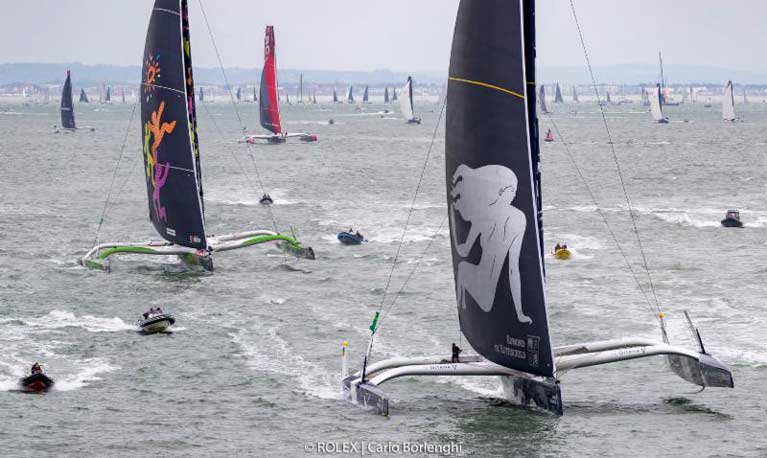 The four 100ft Ultime trimarans were in their own Fastnet world, but they carried it off with such style that everyone was with them. Photo: Rolex
The four 100ft Ultime trimarans were in their own Fastnet world, but they carried it off with such style that everyone was with them. Photo: Rolex
Inevitably, there have been retirals. Michael O’Donnell’s new J/121 Darkwoood, overall winner of the RORC Chanel Race a fortnight ago, had to pull out at an early stage, and today in the final approaches to the Fastnet Rock, Keith Miller’s Yamaha 36 Andante from Kilmore Quay had to call it a day, and she’s headed home at 6 knots.
It will take some time before the final pieces are in place, and the eventual destination of the Roger Justice Trophy will be of special interest. The world meanwhile moves on. The word is that Wizard may be aiming to do the Hong Kong to Vietnam Race on October 19th, which is just about as different from the Fastnet experience as can be imagined, though it does leave them handily enough placed for the Sydney-Hobart on December 26th. But perhaps even as we think of it, the organisers of the Middle Sea Race out of Malta on October 19th – the 40th edition – are working on getting Wizard in their lineup. There’s a certain logic to it.
Race Tracker & Leaderboard here
Stronger Winds in Fastnet Race Give Smaller Boats a Tough Time But Faster Speeds to the Finish
Strong southwest winds last night – with Met Eireann issuing a Small Craft Warning at 2100 hrs – gave the more determinedly sailed smaller craft a fighting chance of significantly improving their overall standing in the Rolex Fastnet Race 2019, though much of the fleet found that what had already been rough going had become decidedly challenging writes W M Nixon.
However, at this stage of an extraordinary race, boat size no longer seems relevant, as extra-special little craft are scampering along in clouds of spray beside boats twice their size, yet often with even more speed.
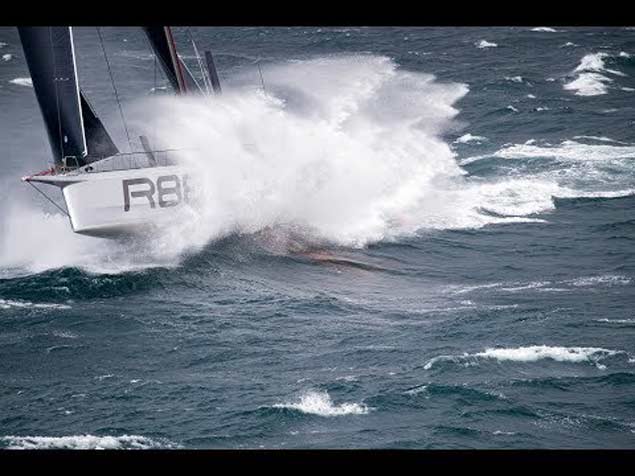 As much wind as anyone might want – Rambler 88 approaching the Fastnet. Photo: Rolex
As much wind as anyone might want – Rambler 88 approaching the Fastnet. Photo: Rolex
At the finish in Plymouth, at time of writing the only unassailable position is that of George David’s Rambler 88 as Line Honours Winner. While the overall leader corrected time leader continues with ever-growing strength to be the Volvo 70 Wizard owned by Americans David & Peter Askew and skippered by Charlie Enright, second overall is now held by the Mach 45 Bretagne Telecom (Nicholas Groleau), yet another French flying machine from specialist builders, and a boat which despite her size came sweeping into the finish among the likes of 72ft Mini Maxis and IMOCA 60s – a reminder that other speed disruptors are still racing and posing a challenge.
 George David’s Rambler 88 rounding the Fastnet at 1645 on Sunday
George David’s Rambler 88 rounding the Fastnet at 1645 on Sunday
Third overall and finished is currently the Botin 52 Tala (David Collins, UK) which likewise punched above her length, but as we move down the rankings of finished boats, we’re increasingly getting among craft whose position is at risk from the way the wind is expected to hold up well enough to bring little boats in at good speed, and the night saw some formidable performances recorded when the wind was going strong.
"At this stage of an extraordinary race, boat size no longer seems relevant"
It has emerged that Conor Fogerty’s Raw is not alone of her type, she is one of three foiling Figaro 3s taking part, and for a while they were in fairly close contention with each other while suffering as a trio from their boats’ extraordinarily high rating.
 The Mini Maxi Jethou heads away from the Fastnet Rock under restless-looking skies late on Sunday evening. She has finished and lies 15th overall on IRC
The Mini Maxi Jethou heads away from the Fastnet Rock under restless-looking skies late on Sunday evening. She has finished and lies 15th overall on IRC
But last night one of them with the unlikely name of Les Drus – Sl Maintenance (no, we don’t know either) sailed by Charmy Laurent got it all together on the foiling front, and did a horizon job on every boat around her, rocketing along at speeds pushing towards 15 knots and better, and moving up the fleet until this morning she’s approaching the Lizard (though now only at 11.2 knots) at 7th in IRC 1 and third in IRC 1B, though still shown as 24th overall in IRC.
Raw meanwhile is closing in on the Scillies, currently at 12.7 knots and placed 30th in IRC1, and 17th in IRC1B. Thus the best-placed boat of Irish interest continues to be the Ker 40 Keronimo with Kenneth Rumball and Barry Hurley on board, estimated 5th in IRC 1A and expected to finish at mid-morning.
Tom Dolan and Janusz Madej in the latter’s Sun Fast 3600 One Way continue to put in a good showing in the Two-Handed Class where they lie 5th, while they’re fourth in IRC4A, but for Irish observers as for everyone else, the story of the second night of the Rolex Fastnet Race 2019 has been the exceptional performance of the French-designed-and-built JPK range of boats in all the classes in which they’re represented.
In fact, if you’re in a boat-buying mood for a surefire race winner this morning, we’d suggest you try placing an immediate order for one of the new JPK 10.30s. But you mightn’t find anyone at the workshops in Lorient to take your order, as the boss Jean-Pierre Kelbert is racing the JPK 10.30 Leon in the Fastnet in the two-handed division with Alexis Loison, and at time of writing, they’re southwest of Land’s End closing towards the Lizard at 10.8 knots.
Currently, they’re first in the Two-Handed, and first in IRC 3 and in IRC3B, and will surely have improved on their 15th in IRC Overall if they can maintain this pace to the finish.
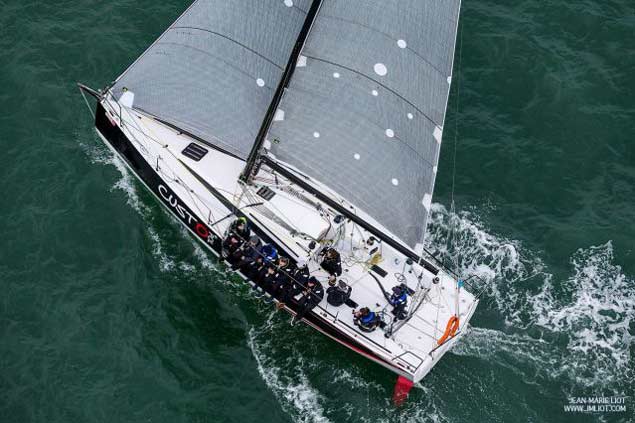 Gery Trentesaux’s JPK 11.80 Courrier Reommande is providing a nail-biting finish at Plymouth this morning
Gery Trentesaux’s JPK 11.80 Courrier Reommande is providing a nail-biting finish at Plymouth this morning
That said, the current pace is slow by comparison with their overnight performance, when they were hitting 15 knots and better as the frontal system went through, and their performance has been emulated by seasoned JPK campaigner Gery Trentesaux with the JPK 11.80 Courrier Recommande, which is very likely leading IRC 2 and IRC 2 A, but as his Tracker has been on the blink, we can’t precisely say where he is for now, except that he’s very much at the races. And even as we finish writing this piece, he’s back in communication with 24 miles to the finish, 10.3 knots on the clock, and a good chance of second overall or even better on IRC, in addition to class victories every which way.
The JPK sweep is completed by Noel Racine with the veteran JPK 10.10 Foggy Dew holding first in IRC 4 and IRC 4A, making for a trio of success which puts pretty much everything else in the shade. For sure, the wonderful performance by the Volvo 70 Wizard is looking increasingly unassailable, for though the very brisk sou’wester should hold up well in the approaches to Plymouth today, the astonishing little boats are increasingly a long shot for the top prize. But their dominance within classes is unrivalled and of real interest to serious club sailors who go offshore racing.
Later today, the next report will include an overview of the performance of other Irish boats in this hectic race.
Race Tracker & Leaderboard here
Charal Claims IMOCA 60 Fastnet Race Honours
While IMOCA 60s are renowned for racing non-stop around the world in the Vendée Globe, the doublehanded crews of these extraordinary space-age craft appreciate the Rolex Fastnet Race as it offers most conditions of a round the world race within just a few days writes James Boyd.
With the IMOCA 60s going through a revolution - following the introduction of foils, one design keels and masts, and being chosen as the Grand Prix boat of The Ocean Race, there has been huge interest in how they are performing, especially as some are new builds and other have been upgraded to differing degrees.
As usual, all the IMOCA 60s were being sailed doublehanded in preparation for this autumn's Transat Jacques Vabre.
Class act of this year's Rolex Fastnet Race was Solitaire du Figaro winner Jérémie Beyou and Christopher Pratt on the new generation VPLP design Charal.
Twenty IMOCA 60s set sail in the Royal Ocean Racing Club's biennial Rolex Fastnet Race and, as forecast, it was the unusual and near impossible-to-predict transition on the first evening between southeasterly gradient to southwesterly pre-frontal breeze that would prove the race's 'defining moment'.
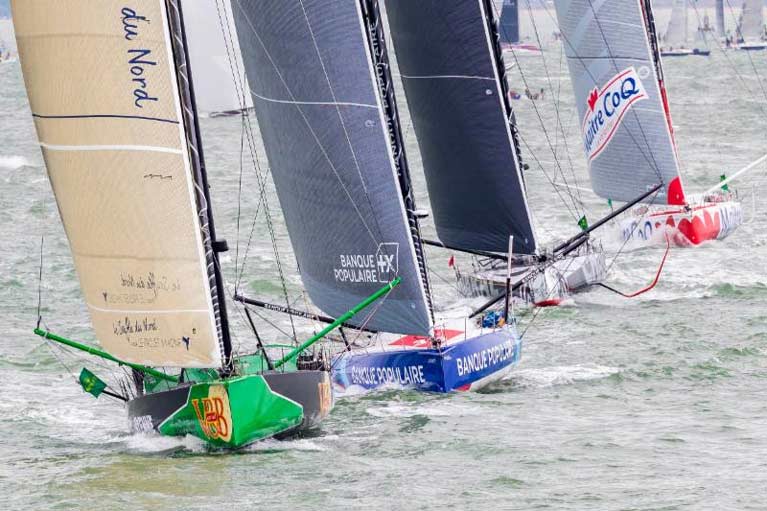 Twenty IMOCA 60s at the start of the Rolex Fastnet Race © Rolex/Carlo Borlenghi
Twenty IMOCA 60s at the start of the Rolex Fastnet Race © Rolex/Carlo Borlenghi
Out of the Solent, PRB, sailed by Nicolas Lunven and her new skipper Kevin Escoffier, led, with Clarisse Cremer and Vendée Globe winner Armel le Cleac'h on board Banque Populaire and Charal both to leeward. However here Charal demonstrated the power of her foils, forging ahead past the north of the Casquets traffic separation scheme (TSS) with Louis Burton and Davy Beaudart aboard Bureau Vallée leading the southerly group.
Alongside the top IRC Zero boats, like Rambler 88, Wizard and Sorcha, they headed southwest out into the middle of the channel... only for the wind to disappear almost completely and chaos to rein. As Sam Davies, sailing Initiatives Coeur with Route du Rhum winner Paul Meilhat, described it: "We went backwards for a while. I think we tried to draw a heart...because Initiatives Coeur is all about saving kids with heart problems. It was frustrating."
Meanwhile British IMOCA 60 newbie Pip Hare and the fastest man on the water, Australian Paul Larsen were trickling along in breeze to the north on the shortest course. Ultimately they enjoyed several blissful hours of fame as their ancient 20 year old boat led the entire IMOCA 60 fleet past the Lizard.
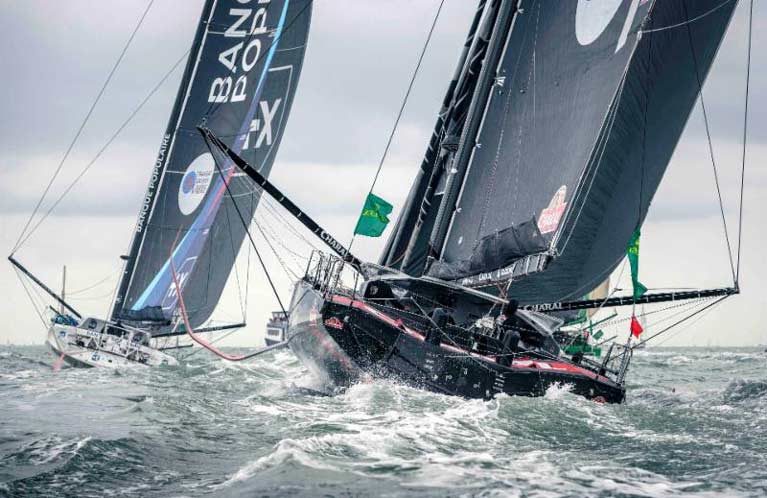 Banque Populaire and Charal © Rolex/Kurt Arrigo
Banque Populaire and Charal © Rolex/Kurt Arrigo
Beyou observed: "It was strange because I think they had wind from the north, which they should never have had! That was a good call by them." Sébastien Simon and Vincent Riou on the new Juan K-designed Arkea Paprec were first of southerly group to notice the north paying, gybing to get a piece of it.
Hare and Larsen were eventually overtaken at the Scilly Isles, when Charal once again regained the lead ahead of Banque Populaire.
Outbound to the Fastnet Rock, Charal extended her lead to 15 miles. It was also lively, said Beyou: "It was very difficult because the wind was stronger than expected. We had 35 knots when I was expecting 25! It was wild reaching and the sea was rough."
On port tack, the wind was also veering. This left Charal 10 miles further east than they'd hoped, forcing them to short tack west (no mean feat just two up) along the top of the Fastnet TSS and the Irish coast to reach the Fastnet Rock. This they finally rounded after an elapsed of 1d 8h 52m 38s (outside of Marc Guillemot and Safran's record time of 1d 6h 36m 0s).
Rounding some 20 minutes later were Vendee Globe veterans Yannick Bestaven and Roland Jourdain on Maître CoQ (ironically under whose colours Beyou sailed the last Vendée Globe) with Initiatives Coeurs another 20 minutes behind.
On the run back to the Scilly Isles, Maître CoQ drew level with Charal. This was due to their having to make some laborious sail changes, reported Beyou. "We were broad reaching at 120° TWA under full main and J2 after the Fastnet TSS. Then we changed to the A3, which was the manoeuvre where we lost a lot." During this period Charal hit her top speed of the race - 33-34 knots.
Charal passed Bishop Rock to the west of the Scilly Isles at 0630 this morning while behind a four way fight was developing between Banque Populaire, Maître CoQ and Initiatives Coeurs and Bureau Vallée 2.
Through judicious covering, Charal kept herself between those chasing and the Plymouth breakwater finish line where she arrived at 14:02:28 BST in an elapsed time of 2d 1h 32m 28s (outside of the PRB's 2011 record of 1d 23h 21m 27s). Impressively this was only around 1.5 hours more than Peter Harrison's Maxi 72 Sorcha, being sailed with large talented armies of crew. As Beyou observed: "They were gybing a bit better than us..."
Overall Beyou said of this year's race: "It was nice - a tough one because every time we were leading, people kept coming back into us. Anyway, we were first which is a good accomplishment for the team, because in the last two races we've had to stop. It has been good to see the boat perform in different conditions - upwind, downwind, light wind, strong wind."
It was also a good opportunity to learn about their giant foils. As Christopher Pratt noted: "Even if you changed something tiny, it is not a gain of 0.2 knots, it is a gain (or a loss) of 2 knots..."
More delighted than Beyou was Kevin Escoffier and Solitaire du Figaro winner Nicolas Lunven on board PRB, who finished second. This season Escoffier, who was in Dongfeng Sailing Team's Volvo Ocean Race-winning crew, has been bequeathed the IMOCA 60 sponsorship of Vendée-based house cladding company PRB. Second place came despite being on a boat with a 2010 vintage hull, albeit fitted with Juan K-designed foils for last year's Route de Rhum.
"We had a good start and were leading at the Needles," recounted Escoffier. "But then we followed the forecast too much because conditions were definitely not what were forecast. We should have gone directly towards the Scillies earlier rather than hunting the new wind. But then we were quite fast reaching to the Fastnet."
During the race Escoffier said they had done 32 knots and sometimes 30 constantly. "That was a bit too fast but it was good to practice on the boat and I am very happy to have done so well on my first race as skipper of PRB."
The Rolex Fastnet Race was good for its female skippers with Clarisse Cremer on Banque Populaire third and Sam Davies on Initiatives Coeur fifth, behind Bureau Vallée 2. At the time of writing Pip Hare and Paul Larsen were lying in 14th and Miranda Merron and Halvard Mabire 17th on Campagne de France.
"I think we deserved more than a fifth place," said Davies. "There were a couple of mistakes we could have avoided, but it was such fun to send it across the Celtic Sea and back and really try out the boat in conditions that were tough and rough, but not too tough and rough that you had to slow down. It was cool seeing 'who hoons the fastest'!" Like Escoffier, Davies added it was particularly satisfying to see that her boat, which has been fitted with enormous foils over the winter, can now stay up with the 2016 generation foiling boats.
Their 'mistakes' were a bow compartment flood when one of the foil hatches blew off. "There was a water alarm going off, but we knew we'd soon be in the lee at the Fastnet Rock and would slow down. But when I went forward, I got a nasty surprise because the water was up to my thighs! That required a lot of pumping!"
They also got something caught round their keel and were forced to back down to remove it. "When you are doing 25 knots, you lose about five miles just doing that."
Ashore Davies was swaying and just keeping her eyes open. "I'm very tired," Davies concluded. "But that is normal at the end of the Rolex Fastnet Race. It's been like that for the last three times I've done it. I have never felt as tired as after any other race. Still, I'm happy.
The Ultime Trimarans Live Up to their Name as Leading Pair Finish Fastnet Race in Record Time
The new breed of Ultime 32 trimarans have lived up to their name and reputation with the leading pair of Gitana XVII and Macif slashing more than four and a half hours off the record time for the 608-mile Rolex Fastnet Race when they finished at Plymouth this afternoon just one minute apart, at 1632 and 1633 hrs writes W M Nixon.
The previous record was set in 2011’s breezy race by Loick Peyron with the 130ft trimaran Banque Populaire V at 1 day 8 hours and 48 minutes, an average of 18.5 knots. But despite being virtually becalmed for an hour and more on the outward passage, this year the smaller new designs have proven to be extremely potent machines, while having a significant proportion of the course sailed as a beam reach was very much to their advantage.
At the Fastnet Rock at 0630 BST this morning, Gitana XVII (aka Maxi Edmond de Rothschild) skippered by Franck Cammas and Charles Caudrelier, was narrowly in the lead. But in some extra-swift sailing in an already fast leg to the next turn at the Bishop Rock, the western outpost of the Isles of Scilly, sister-ship Macif (Francois Gabart) took over the lead and hung onto it thereafter sometimes opening it up to as much as two miles. Yet at the finish Gitana snatched it back again by just 59 seconds.
Some idea of the relative speed of the multihulls can be gauged from the fact that at precisely the time they finished in Plymouth, the leading mono-hull, George David’s Rambler 88, was in process of rounding the Fastnet Rock, having opened out a half mile lead on Seng Huang Lee’s 100ft SHK Scallywag from Hong Kong, while Peter and David Askew’s Volvo 70 Wizard is now six miles astern of Rambler, but still leading IRC overall on corrected time.
The southwest breeze has now filled in along the south coast of Cornwall and Devon and the rest of the entire fleet is steadily on the move past the Lizard and on past the Isles of Scilly. In overall IRC placings, the boat of Irish interest currently doing best is the Ker 40 Keronimo with Kenneth Rumball and Barry Hurley on board – their 23rd overall means they’re fifth in IRC 1 and 4th in IRC 1A.
Although conditions are favourable going to and from the Fastnet, with winds at the rock south of southwest at the moment, an expected change will see a veer which may see the smallest boats racing in more difficult conditions with the wind forward of the beam, while tail-enders back at the Isles of Scilly may even find themselves hard on the wind tomorrow.
Meanwhile this afternoon’s last-minute victory by Gitana IV is another extraordinary episode in the story of Rothschild involvement in top level sailing. It began in 1965 when the Baron Edmond de Rothschild was persuaded to take his luxurious but surprisingly fast Sangermani yawl Gitana IV in the Fastnet Race.
At 90ft, Gitana IV was at the time the biggest boat ever to do the race, and naturally the baron brought his personal chef along so that he and his sailing friends could enjoy one of the legendary and leisurely Rothschild lunches every day. It was around 1.0pm on the second day when Gitana was approaching the Fastnet Rock, and the professional skipper went below to advise the owner of the impending historic moment.
The Baron and his friends were already well into lunch and an animated conversation, but he turned briefly to his skipper and said; “Please do not interrupt us when we are in the enjoying luncheon”, and he left the skipper to record the rounding of the rock.
These days, times have changed – those 59 seconds at Plymouth are going to get some deep attention at every level of the Rothschild world.
 The 90ft Gitana IV – in the 1965 Fastnet Race, enjoying a proper lunch took priority over witnessing the rounding of the Fastnet Rock
The 90ft Gitana IV – in the 1965 Fastnet Race, enjoying a proper lunch took priority over witnessing the rounding of the Fastnet Rock
Race Tracker & Leaderboard here
For most sailors a fair wind from well aft of the beam is welcome. But if you happen to be a 100ft trimaran which three hours ago was registering 38 knots on a beam reach, the fact that the wind is now drawing from astern is bad news writes W M Nixon.
It was no surprise when the four Ultime 32s from France led the Fastnet Race fleet out of the Solent early this afternoon in a south to southeast breeze. They’d been first away with their start at 1230 to keep them clear of everyone else, and even in the Solent they’d been pushing towards 20 knots. Out in the Channel with a fine commanding southerly breeze on the beam, the fastest were showing bursts of 38 knots, including Maxi Edmond de Rothschild which seems to have recovered from the indignity of briefly kissing the Shingles Bank – not something to be encouraged when you come complete with all sorts of fancy appendages such as foils of various kinds.
But having hurtled away towards the western horizon, as they closed in towards the coast of Devon the wind may have stayed with them, but it backed into the east. Thus instead of making good progress on the direct line, they’d to resort to tacking to lee to maintain best VMG, yet for smaller slower boats which were hitting hull speed while dead running, the easterly breeze was just grand.
If the Ultime 32s can get themselves clear to the west of the Lizard Point this evening, they should begin to enjoy a worthwhile south to southwest wind which is forecast to settle in over the area between Land’s End and the Fastnet across the mouth of the Celtic Sea, and that will bring them to their rounding of The Rock tomorrow morning as predicted here, but the weather system is unstable, and the low pressure area settling over Ireland is distinctly anaemic.
Meanwhile, in the enormous and now spread out fleet, overall it seems that the ever-reliable products of the JPK workshops in Lorient continue to do the business – at the most recent check-in, former Fastnet winner and general sailing superstar Gery Trentesaux of France was vying for the overall lead on IRC with the JPK 11.80 Courrier Recommande against the JPK 10.80 Dream Pearls, with another JPK 10.80 also in the hunt. However, with a fleet this size at such an early stage of the race, the position changes by the minute.
Of the boats of Irish interest, the Swan 36 Finola with Graham Curran on board was 18th overall – only a matter of minutes behind the leader – while the Swedish Ker 40 Keronimo with Kenneth Rumball and Barry Hurley on the strength was waiting to pounce at 21st overall.
Tracker here

